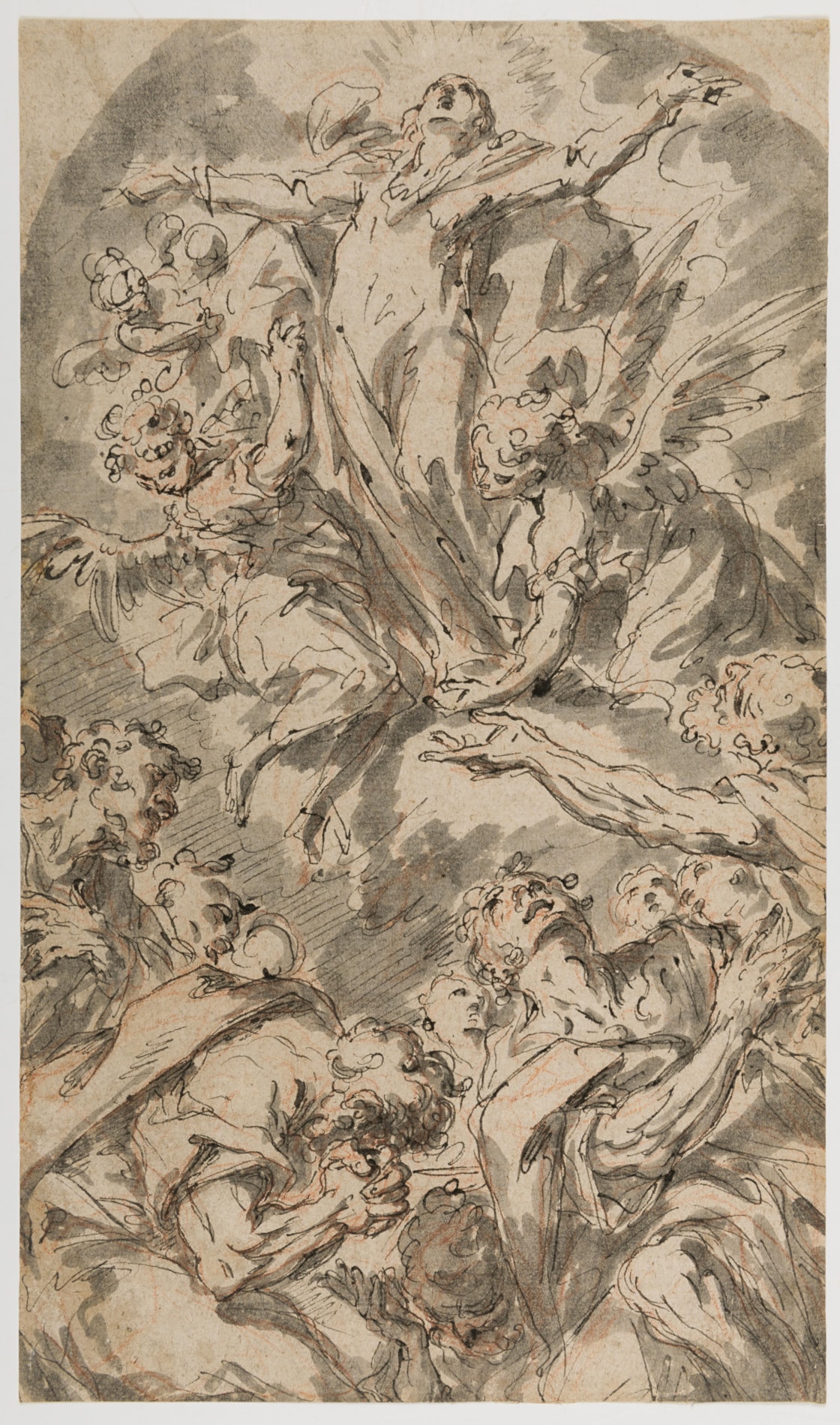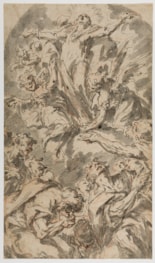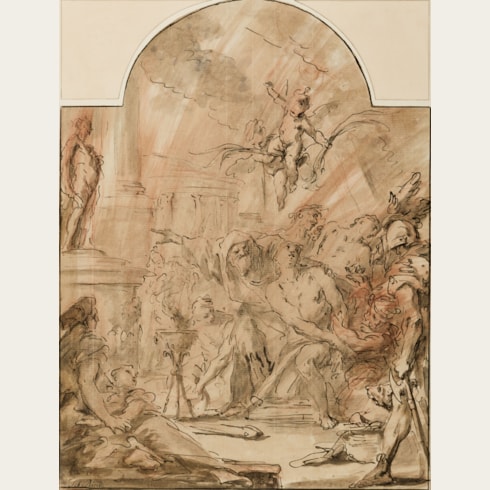Gaspare DIZIANI
(Belluno 1689 - Venice 1767)
The Assumption of the Virgin
Pen and black ink and grey wash, over an underdrawing in red chalk.
A half-length study of a male nude leaning forward, drawn in red chalk, on the verso.
Inscribed Cesari d’Arpino / Mariae Himmelfahrt Feder u… / [?] 1890 on the verso.
430 x 251 mm. (16 7/8 x 9 7/8 in.)
A half-length study of a male nude leaning forward, drawn in red chalk, on the verso.
Inscribed Cesari d’Arpino / Mariae Himmelfahrt Feder u… / [?] 1890 on the verso.
430 x 251 mm. (16 7/8 x 9 7/8 in.)
As one modern scholar has commented, ‘in a manner which is not unique in the Venetian Settecento, [Gaspare Diziani] emerges as a more interesting and gifted artist in his drawings than in his paintings.’ Diziani was a productive draughtsman, and the largest surviving group of drawings by the artist, numbering almost two hundred sheets, is today in the Museo Correr in Venice; most of these come from an album assembled by the late 18th century Venetian collector Ascanio Molin. Other significant holdings of drawings by Diziani are in the Louvre in Paris, the Hermitage in St. Petersburg and the Albertina in Vienna, while another fine and varied group is in the Städel Museum in Frankfurt.
The scholar Filippo Pedrocco has noted of Diziani that ‘His large body of graphic work is of particularly high quality, including numerous preparatory drawings for his paintings that give some idea of his mastery of a variety of techniques. His drawing is spontaneous and excitable, with lines sometimes worked over several times.’ While Diziani’s drawings often display the particular influence of the draughtsmanship of his master Sebastiano Ricci, they also show stylistic similarities with the pen manner of his slightly younger Venetian contemporary, Giovanni Antonio Pellegrini, and the drawings of all three artists have often been confused. Andrew Robison has further pointed out that ‘Like several other Venetian artists of the eighteenth century, Diziani frequently used red chalk for his initial sketch. That, combined with gray or brown pen and ink and wash created richly coloristic works.’
Unlike the majority of the artist’s extant drawings, the present sheet is quite highly finished and elaborate in composition. As such, it may have been intended as much as an autonomous work of art as a study for a proposed altarpiece. Although some of the figures are in reverse, the composition of this drawing is akin to that of Diziani’s oil sketch modello for an altarpiece of The Assumption of the Virgin of c.1734-1740, today in the Los Angeles County Museum of Art, as well as to another, smaller bozzetto of the same subject and approximate date, formerly in a private collection in Belluno. A double-sided drawing in the Museo Correr in Venice can be related to the Belluno bozzetto, and incorporates a similar ascending Virgin to that seen in this drawing. Diziani produced a number of other drawings of the Assumption of the Virgin, although most are considerably freer in handling than the present sheet. The Virgin appears in a similar pose in one such study, a drawing sold at auction in 1981, and also in a drawing of the Immaculate Conception in the Louvre.
While the male nude drawn in red chalk on the verso of the present sheet cannot be definitively related to any surviving painting by Diziani, its pose is close, albeit in reverse, to that of a figure in the foreground of a large ceiling fresco by the artist in the Palazzo Belloni in Venice, painted in the 1750s, as well as one of his illustrations for an edition of Dante’s Divine Comedy, published by Antonio Zatta in Venice in 1757.
Born in East Prussia, Werner Gramberg (1896-1985), was an art historian and collector. He completed a doctorate on the sculptor Giambologna in 1928, and worked at the State Museums in Berlin. In 1934, however, he was forced to leave his post in Berlin because his wife was part Jewish. Gramberg settled in Hamburg in 1945, and four years later was named curator of the numismatic collections of the Kunsthalle in Hamburg, later serving as head of the sculpture collections and Deputy Director. In 1957 he took up a post as professor of art history at Hamburg University. An expert in Italian Renaissance art, he was a co-founder of the Stiftung zur Förderung der Hamburgischen Sammlungen, working actively within the foundation until his death in 1985. Gramberg’s collection included an important group of sculptures, paintings and drawings, many of which were bequeathed to the Hamburger Kunsthalle. One of the last drawings he acquired, this Assumption of the Virgin by Diziani has remained in his family’s collection until recently.
The scholar Filippo Pedrocco has noted of Diziani that ‘His large body of graphic work is of particularly high quality, including numerous preparatory drawings for his paintings that give some idea of his mastery of a variety of techniques. His drawing is spontaneous and excitable, with lines sometimes worked over several times.’ While Diziani’s drawings often display the particular influence of the draughtsmanship of his master Sebastiano Ricci, they also show stylistic similarities with the pen manner of his slightly younger Venetian contemporary, Giovanni Antonio Pellegrini, and the drawings of all three artists have often been confused. Andrew Robison has further pointed out that ‘Like several other Venetian artists of the eighteenth century, Diziani frequently used red chalk for his initial sketch. That, combined with gray or brown pen and ink and wash created richly coloristic works.’
Unlike the majority of the artist’s extant drawings, the present sheet is quite highly finished and elaborate in composition. As such, it may have been intended as much as an autonomous work of art as a study for a proposed altarpiece. Although some of the figures are in reverse, the composition of this drawing is akin to that of Diziani’s oil sketch modello for an altarpiece of The Assumption of the Virgin of c.1734-1740, today in the Los Angeles County Museum of Art, as well as to another, smaller bozzetto of the same subject and approximate date, formerly in a private collection in Belluno. A double-sided drawing in the Museo Correr in Venice can be related to the Belluno bozzetto, and incorporates a similar ascending Virgin to that seen in this drawing. Diziani produced a number of other drawings of the Assumption of the Virgin, although most are considerably freer in handling than the present sheet. The Virgin appears in a similar pose in one such study, a drawing sold at auction in 1981, and also in a drawing of the Immaculate Conception in the Louvre.
While the male nude drawn in red chalk on the verso of the present sheet cannot be definitively related to any surviving painting by Diziani, its pose is close, albeit in reverse, to that of a figure in the foreground of a large ceiling fresco by the artist in the Palazzo Belloni in Venice, painted in the 1750s, as well as one of his illustrations for an edition of Dante’s Divine Comedy, published by Antonio Zatta in Venice in 1757.
Born in East Prussia, Werner Gramberg (1896-1985), was an art historian and collector. He completed a doctorate on the sculptor Giambologna in 1928, and worked at the State Museums in Berlin. In 1934, however, he was forced to leave his post in Berlin because his wife was part Jewish. Gramberg settled in Hamburg in 1945, and four years later was named curator of the numismatic collections of the Kunsthalle in Hamburg, later serving as head of the sculpture collections and Deputy Director. In 1957 he took up a post as professor of art history at Hamburg University. An expert in Italian Renaissance art, he was a co-founder of the Stiftung zur Förderung der Hamburgischen Sammlungen, working actively within the foundation until his death in 1985. Gramberg’s collection included an important group of sculptures, paintings and drawings, many of which were bequeathed to the Hamburger Kunsthalle. One of the last drawings he acquired, this Assumption of the Virgin by Diziani has remained in his family’s collection until recently.
Born in the town of Belluno, some one hundred kilometres north of Venice, Gaspare Diziani was trained in the Venetian studios of Gregorio Lazzarini and Sebastiano Ricci. The latter artist, who was also from Belluno, was to become a decisive influence on the paintings of the young painter. Diziani worked in Venice for most of his life, apart from a brief period between 1717 and 1720 in Dresden, where he was active as a scenographer at the court of Augustus II the Strong, and in Munich, where he painted overdoors in the Residenz. He also worked for about a year in Rome between 1726 and 1727. Among his earliest known paintings is an Ecstasy of Saint Francis of 1727 in the church of San Rocco in Belluno, which shows the dominant influence of Ricci. An extremely prolific artist, Diziani enjoyed a long and successful career that lasted for more than forty years. He painted numerous altarpieces for churches in Venice, notably a series of three large canvases of The Adoration of the Shepherds, The Flight into Egypt and The Massacre of the Innocents for the sacristy of Santo Stefano, executed in 1733, together with fresco decorations for villas and palaces in the city and throughout the Veneto, as well as in Friuli, Padua, Rovigo, Bergamo and elsewhere. Diziani also worked in collaboration with view painters such as Antonio Joli and Michele Marieschi, painting the staffage in their compositions.
Between 1746 and 1747 Diziani painted a series of mythological frescoes for the Palazzo Avogadro in Castelfranco Veneto, and the following year completed a fresco cycle for the Palazzo Spineda in Treviso. The succeeding decade found the artist at the peak of his activity and success, beginning with a monumental ceiling fresco painted for the church of San Bartolomeo in Bergamo and continuing with other vault frescoes in the Palazzo Contarini, the church of the Angelo Raffaele and the Palazzo Widmann in Venice. Apart from his early activity as a stage designer in Dresden, Rome and Venice, Diziani also produced drawings for book illustrations, notably for Palladio’s Quattro libri dell’architettura and a 1757 edition of Dante’s Divina Commedia. One of the founding members of the Accademia in Venice, Diziani was elected its principe in 1760 and again in 1766, although he died suddenly the following year, before completing his term.
As one modern scholar has commented, ‘in a manner which is not unique in the Venetian Settecento, [Diziani] emerges as a more interesting and gifted artist in his drawings than in his paintings.’ While Diziani’s drawings often display the particular influence of the draughtsmanship of his master Sebastiano Ricci, they also show stylistic similarities with the pen manner of his slightly younger Venetian contemporary, Giovanni Antonio Pellegrini, and the drawings of all three artists have long been confused. Diziani was a prolific draughtsman, and the largest surviving group of drawings by the artist, numbering almost two hundred sheets, is today in the Museo Correr in Venice; most of these come from an album assembled by the late 18th century Venetian collector Ascanio Molin. Other significant holdings of drawings by Diziani are in the Louvre in Paris, the Hermitage in St. Petersburg and the Albertina in Vienna, while another fine and varied group is in the Städel Museum in Frankfurt.
Between 1746 and 1747 Diziani painted a series of mythological frescoes for the Palazzo Avogadro in Castelfranco Veneto, and the following year completed a fresco cycle for the Palazzo Spineda in Treviso. The succeeding decade found the artist at the peak of his activity and success, beginning with a monumental ceiling fresco painted for the church of San Bartolomeo in Bergamo and continuing with other vault frescoes in the Palazzo Contarini, the church of the Angelo Raffaele and the Palazzo Widmann in Venice. Apart from his early activity as a stage designer in Dresden, Rome and Venice, Diziani also produced drawings for book illustrations, notably for Palladio’s Quattro libri dell’architettura and a 1757 edition of Dante’s Divina Commedia. One of the founding members of the Accademia in Venice, Diziani was elected its principe in 1760 and again in 1766, although he died suddenly the following year, before completing his term.
As one modern scholar has commented, ‘in a manner which is not unique in the Venetian Settecento, [Diziani] emerges as a more interesting and gifted artist in his drawings than in his paintings.’ While Diziani’s drawings often display the particular influence of the draughtsmanship of his master Sebastiano Ricci, they also show stylistic similarities with the pen manner of his slightly younger Venetian contemporary, Giovanni Antonio Pellegrini, and the drawings of all three artists have long been confused. Diziani was a prolific draughtsman, and the largest surviving group of drawings by the artist, numbering almost two hundred sheets, is today in the Museo Correr in Venice; most of these come from an album assembled by the late 18th century Venetian collector Ascanio Molin. Other significant holdings of drawings by Diziani are in the Louvre in Paris, the Hermitage in St. Petersburg and the Albertina in Vienna, while another fine and varied group is in the Städel Museum in Frankfurt.
Provenance
Christian Humann, New York, until c.1981
Galerie Arnoldi-Livie, Munich, in 1982
Acquired from them in 1982 by Werner Gramberg, Hamburg
Thence by family descent until 2020.
Galerie Arnoldi-Livie, Munich, in 1982
Acquired from them in 1982 by Werner Gramberg, Hamburg
Thence by family descent until 2020.
Literature
Munich, Galerie Arnoldi-Livie, Vom Manierismus bis in die Goethezeit: Bilder und Zeichnungen, 1982, no.23.






